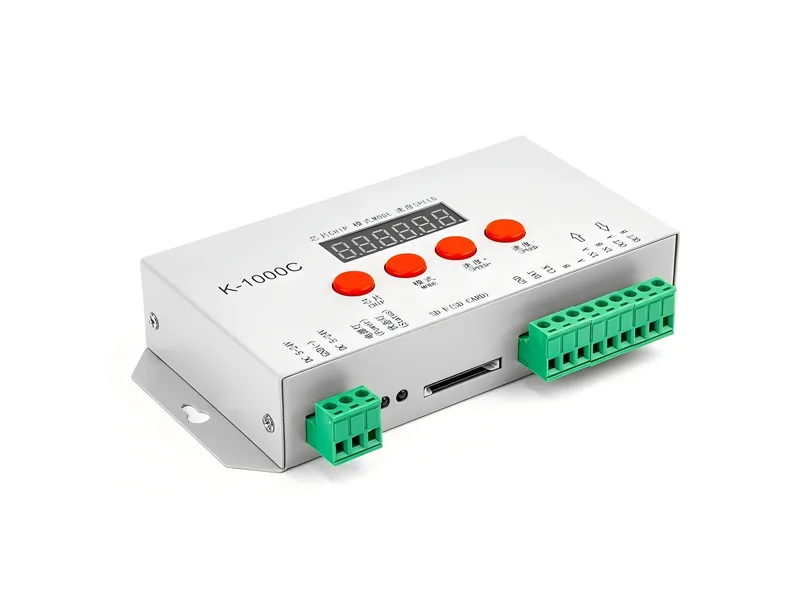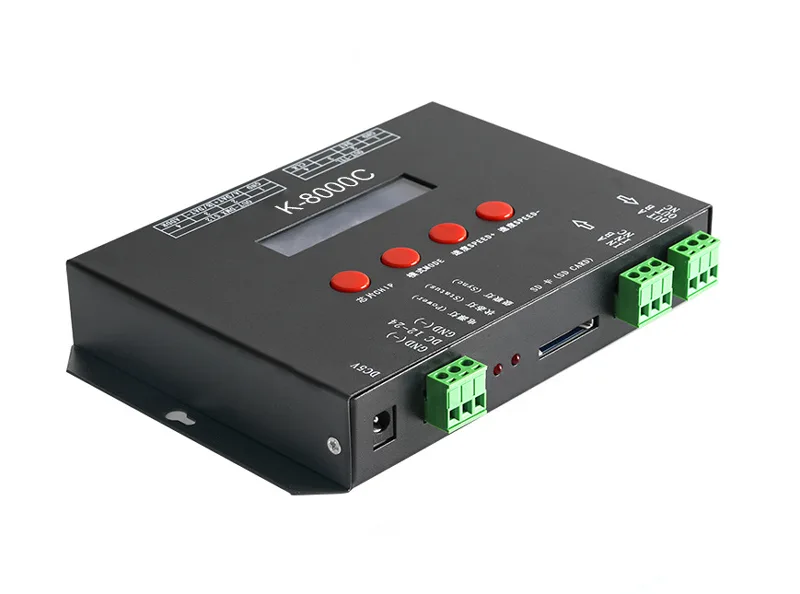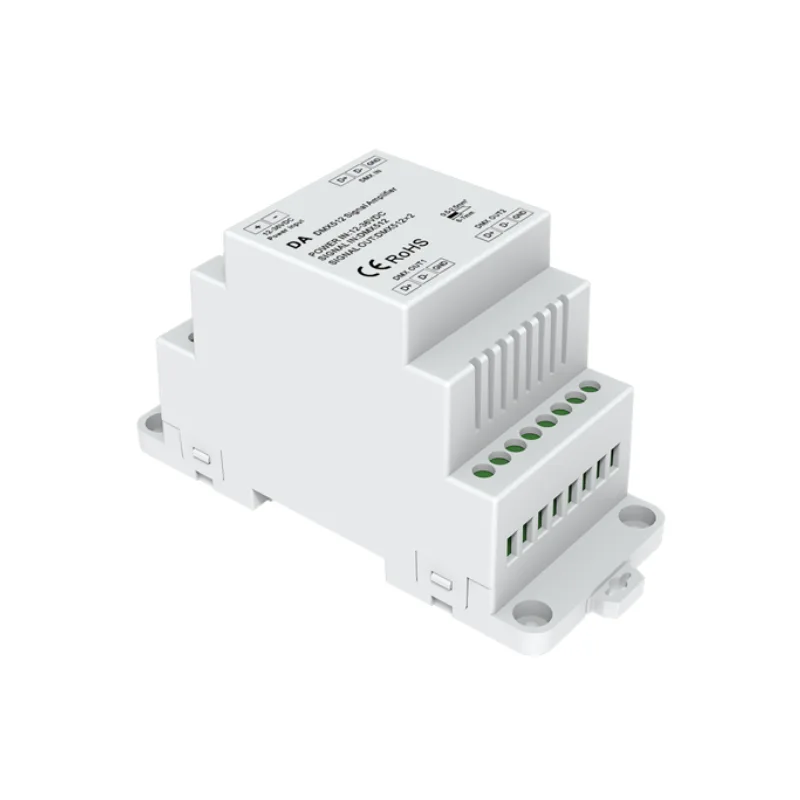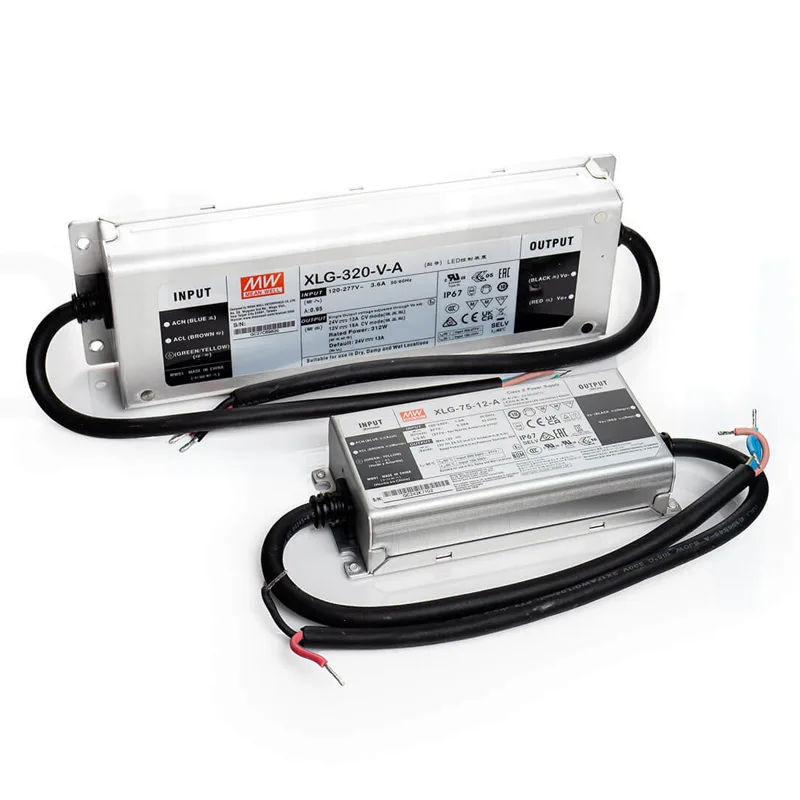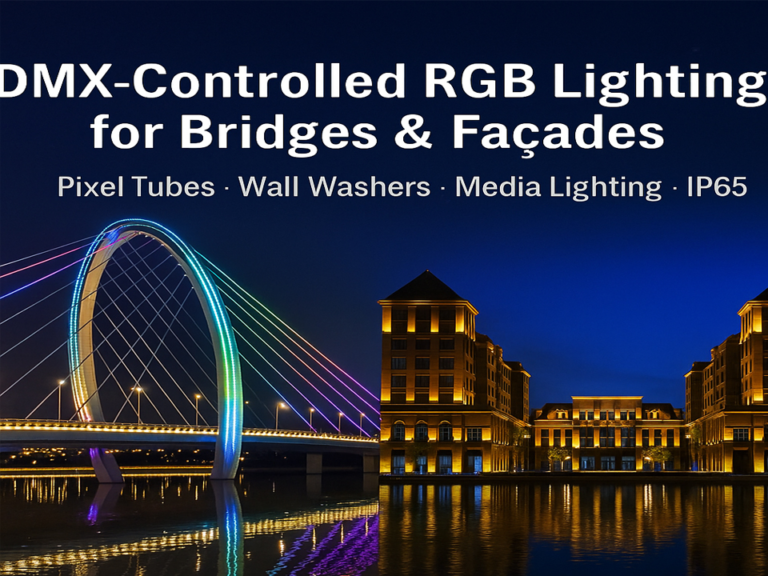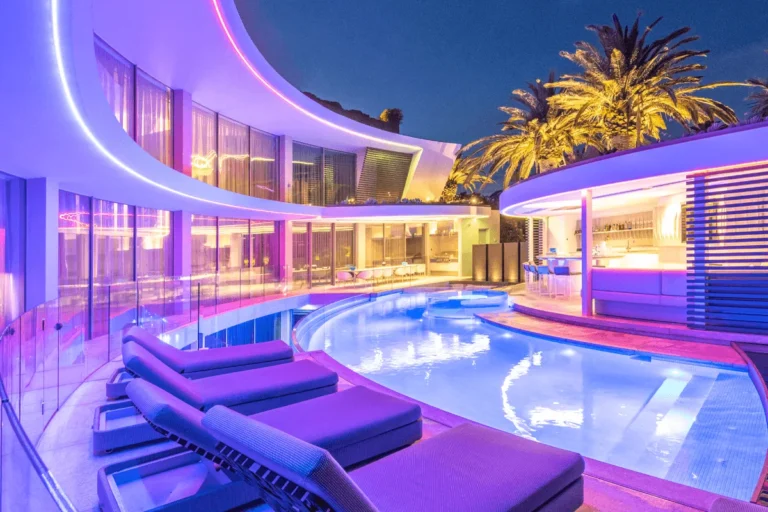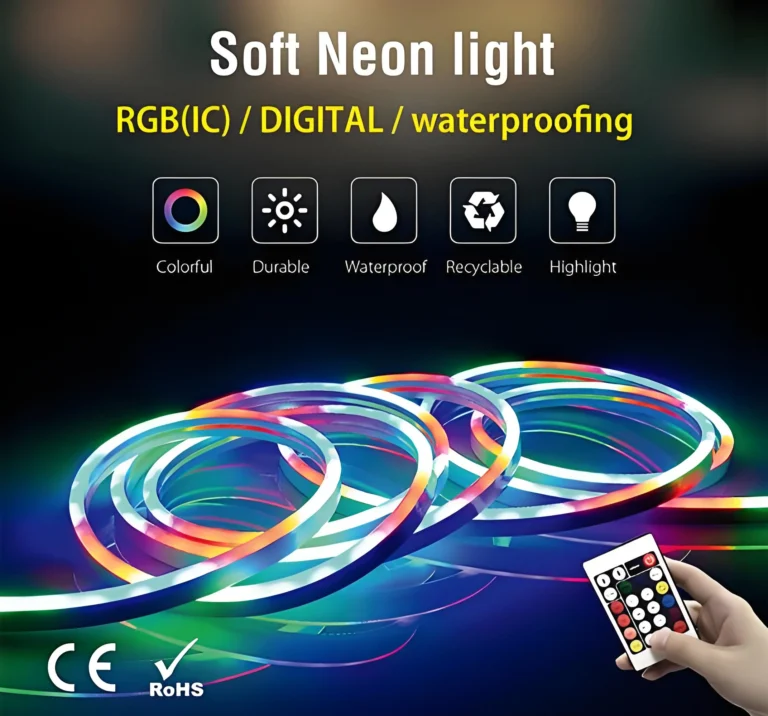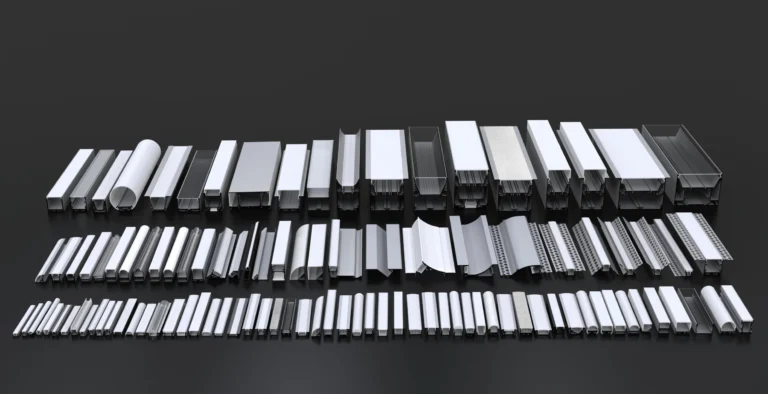新一代 LED 建筑照明正在崛起:LED 柔性霓虹灯可完美融入异形建筑表皮,能耗比传统霓虹灯低 85%,通过 DMX512 智能控制系统,可在单个建筑内实现 256 万种色彩组合。
上海中心大厦的螺旋光效和广州塔的像素化灯光秀,印证了数字照明的无限可能。更值得一提的是与物联网技术的结合--深圳平安大厦的照明系统可以实时响应 PM2.5 数据,并通过光影将城市空气质量可视化。智能照明将建筑外墙变成了一幅数字画布,可以通过编程在节日庆祝和公益活动等场景之间无缝切换。米兰垂直森林的灯光甚至可以模仿树木的光合作用节奏,使建筑成为一个有生命的有机体。
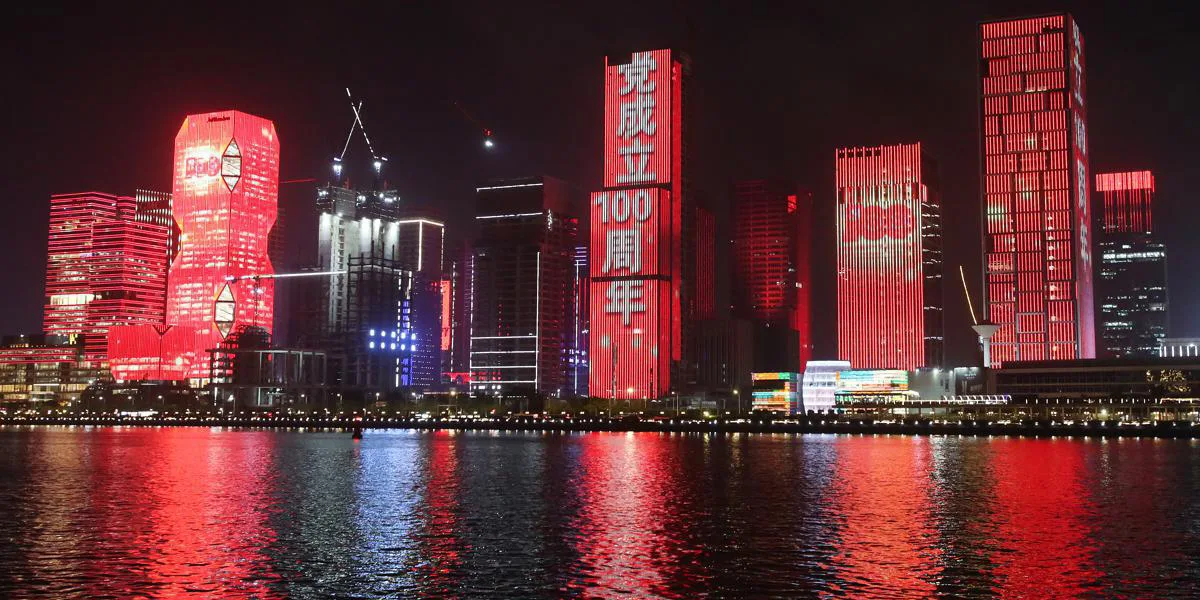
在建筑照明设计中,DMX 控制的 LED 霓虹灯 Flex 以其卓越的灵活性和动态表现力重塑了空间美学。通过 DMX512 协议,设计师可以精确调节每条灯带的亮度、色彩和动态效果,实现从渐进呼吸到复杂节奏的无限创意。本技术指南将分析 DMX 灯光系统的架构、设计要点以及常规设备的产品选择。希望您阅读后能有所帮助,助您的项目更快实施。
DMX512 协议在智能照明中的优势
DMX512 协议通过 512 个独立通道实现逐灯控制,可精确驱动色彩、亮度、动态效果等多维参数,满足舞台、建筑外墙等场景对复杂灯光效果的严格要求。
其毫秒级的响应速度可确保大型灯具的同步运行,尤其适用于动态追光和音乐联动等实时互动应用。它采用主从架构和差分信令,最多可支持 32 个串联设备和数千个节点,具有出色的系统可扩展性。
标准化的接口和强大的兼容性使其能够无缝接入调光器、控制器和各类智能灯具,结合 RS485 物理层抗干扰特性,在工程复杂的电磁环境中保持稳定的传输。
这些技术特点使 DMX 成为大型表演、主题景观、建筑外墙和其他专业照明领域的首选控制解决方案。
为什么在建筑照明中使用 LED 柔性霓虹灯?

使用 用于建筑照明的 LED 柔性霓虹灯条 具有多重优势。首先,其超强的灵活性可以适应复杂的曲面或异形结构,轻松实现建筑轮廓、立面装饰、穹顶环绕等创意设计,赋予灯光艺术更强的表现力。
霓虹灯带采用模块化设计,可自由切割和拼接,以适应不同尺寸的安装场景,大大降低了施工难度。
其次,LED 光源具有高光效、低能耗的特点,配合智能调光系统,能效比传统照明提升 50% 以上,且发热量低,降低了建筑的热负荷。
三是支持 RGB 全彩混光和动态编程,通过 DMX 或无线协议实现色彩渐变、跑马灯、音乐联动等效果,增强了建筑夜景的互动性和科技感。
此外,柔性灯带的外层采用硅树脂或环氧树脂封装,防水等级可达 IP67 或以上,耐候性强,能适应室外温差、雨水和紫外线环境,使用寿命长达 50,000 小时,大大降低了维护成本。其低压供电(12/24 V)的特性也提高了用电安全,是现代建筑照明项目的首选解决方案。
什么是 DMX512 系统?
DMX512 (数字多路复用 512)是一种数字控制协议标准,广泛应用于舞台灯光、建筑照明等领域。它通过数字化信号实现对灯具的精确控制。其核心原理是通过串行通信传输控制命令,每个 DMX 信号链路由一个主控制器(如调光控制台)和多个从设备(灯具、调光器等)组成。系统基于 RS-485 物理层标准,采用差分信号传输技术,抗干扰能力强,最大传输距离可达 1200 米(需扩展中继器)。
每个 DMX 数据帧包含 512 个独立的控制通道,每个通道对应 8 位数据(数值范围 0-255),可以调节灯具的亮度、颜色、运动轨迹等参数。例如,RGB LED 灯具通常占用 3 个通道(红、绿、蓝各 1 个通道),通过地址编码器设置起始通道号后,即可接收相应的指令。控制器以最高 250 kbps 的速率循环发送数据包,每秒刷新约 44 次,以确保灯光变化的实时同步。系统支持链式串行结构;单线最多可控制 32 个设备,通过分线器可扩展至数千个节点,满足大型照明项目的需求。
DMX512 系统的组成主要包括以下部分:
DMX 控制台设备:发送控制信号的主要设备(如照明控制台或软件)。
DMX 接收器解码模块:灯具或其他设备中的解码模块,接收并执行命令。
DMX 电缆:专用屏蔽双绞线,配有 5 针或 3 针 XLR 接头。
终端电阻器:在信号链末端安装一个电阻器(通常为 120 Ω),以防止信号反射干扰。
DMX512 霓虹灯带有什么特点?
- DMX 像素霓虹灯带由多个独立控制的 LED 灯珠(像素)组成。每个像素都可以单独调整颜色(如 RGB/RGBW)和亮度,以形成动态图案或渐变效果。每个 LED 都可独立编程,以实现精致的动画效果(如流水、闪烁、渐变)。
- 与传统霓虹灯相比,它更加节能、耐用,并支持编程控制。
- 用柔性材料(如硅胶、PVC)包裹的 LED 霓虹灯带可以自由弯曲和切割,以适应复杂形状(如曲面、弧形结构)的安装环境。
- 长距离传输(长达 1200 米),兼容性强,可同时控制多个设备。
- 支持高分辨率显示,适用于文本、图案和移动图像。
- 通过 DMX 控制器发送指令,可与摇头灯、激光灯等其他舞台灯光设备同步,营造出统一的效果。
- 支持多宇宙扩展,以满足大规模安装(如建筑外墙、大型舞台)的需要。
- 防水等级高,无惧恶劣的户外环境,通常可达 IP65 或 IP67,适合室内外使用。
- 可切割设计:根据需要调整长度,降低安装复杂性。
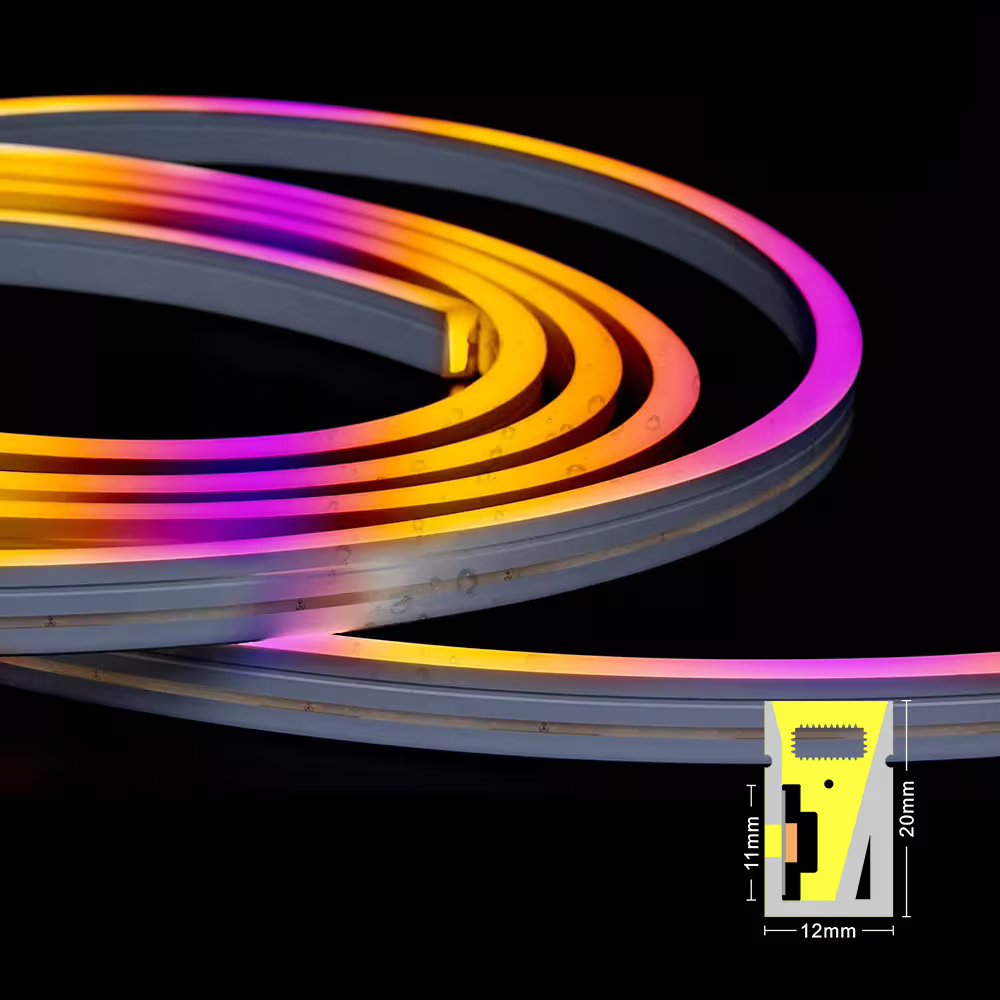
Side Bend S1220 硅胶可寻址 LED 霓虹灯带,用于建筑、墙面玻璃和外墙照明
输入电压DC24V
瓦特:12W/m@RGB,19W/m@RGBW
LED 数量: SMD5050 60LEDs/m
色温:RGB/RGBW(2700K-6500K)
信号类型SPI/DMX512
IP 等级:IP65/IP67
电缆入口:前部
最小弯曲直径:100 毫米
可切割长度:100 毫米
长度:5 米/卷
DMX512 如何控制 LED 霓虹灯带?
DMX512 控制器通过数字信号(遵循 RS-485 标准)向 LED 霓虹灯条系统发送指令;信号经解码器解析后,根据预设地址匹配每个 LED 像素的 RGB 通道数据,从而独立调节亮度(0-255 级)和颜色。通过预设场景编程或实时控制实现动态渐变、同步闪烁等适用于舞台、楼宇等场景的效果,确保多台设备协同工作和抗干扰,具体控制连接方式参考以下电路图。
DMX512 系统连接电路图:
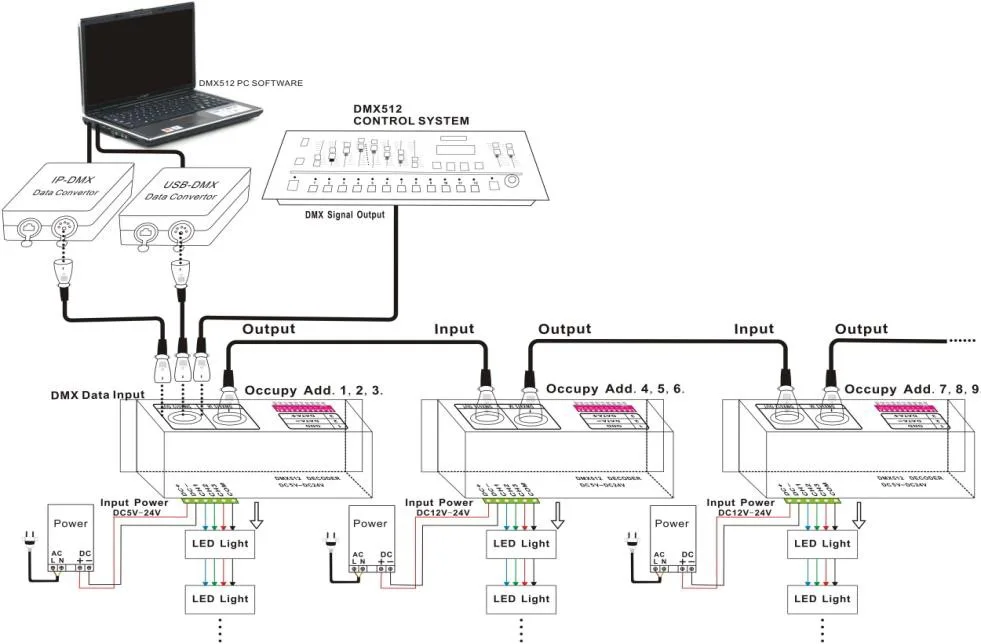
DMX512 控制设备选择
I.DMX512 主控器
DMX512 主控器向 DMX512 解码器输出国际标准 DMX512/1990 信号,以控制单色、双色 CCT、RGB、RGBW 和 RGB+CCT LED 灯光。最常用的有以下两种:
1.DMX512 触摸面板控制器支持 DMX512 输出,内置调光、色温调节、RGB/RGBW 控制功能,可管理区域(最多 4 个区域),并集成多种动态模式(如渐变和跳跃)。其 86 型安装设计适用于商业或家庭场景。
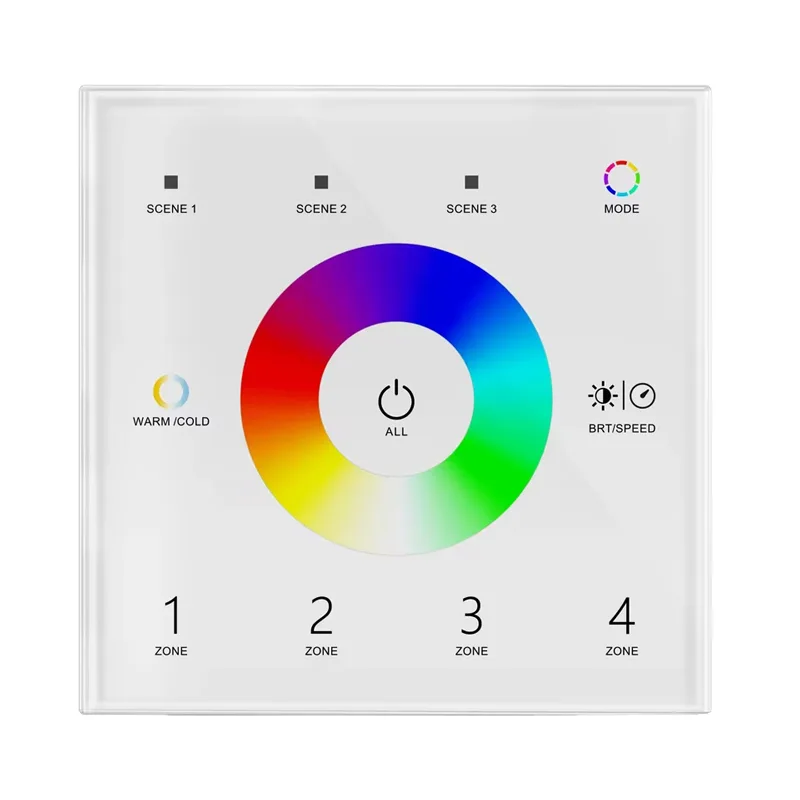
T15 壁挂式 DMX512 触摸面板
触摸面板 4 区 1-5 色 DMX512 主控器也可用作 4 区 1-5 色射频遥控器。
DMX 信号输出,符合标准 DMX512 协议,与任何供应商的 DMX 解码器兼容。
作为射频遥控器使用时,每个区域可遥控多个射频 2.4G LED 控制器、调光驱动器或智能灯具。
超灵敏、高强度。
价格: 24.98 美元/件
2.DMX512 控制器r:DMX512 控制器是用于集中调节和控制舞台灯光和建筑灯光特效设备的核心设备。它通过基于 DMX512 协议的数字信号传输指令。它可以同时管理多个设备(如灯具和电机),精确调节亮度、色彩、动态效果等参数,并通过独立地址识别每个设备对应的通道数据。支持预设场景编程或实时控制,实现灯光变化的同步化和自动化。
K-1000C 和 K-8000C 适用于离线控制。它们既可以单个使用,也可以多个级联使用,以驱动更多的 LED 像素。
a.如果主灯低于 80,000 像素,建议使用 K-1000C DMX 像素控制器。
b.如果主灯为 8000 至 20000 像素,建议使用 K-8000C DMX LED 像素控制器。

II.DMX-SPI 解码器
将 DMX512 信号转换为 LED 灯条可识别的协议(如 SPI)。例如,使用 TM1803 和 UCS512 等芯片,每个芯片对应一个或多个 LED 像素的 RGB 通道控制。
每个 LED 像素需要分配一个独立的地址码,并通过通道映射实现逐点控制(例如,RGB 像素占用三个 DMX 通道)。
它可以由 DMX 控制台控制,还可以连接多个 DMX 解码器来增加输出功率,实现所有功能。多种变化模式。此外,DMX 解码器还可用作同步器。控制器单独控制 LED,实现同步效果。
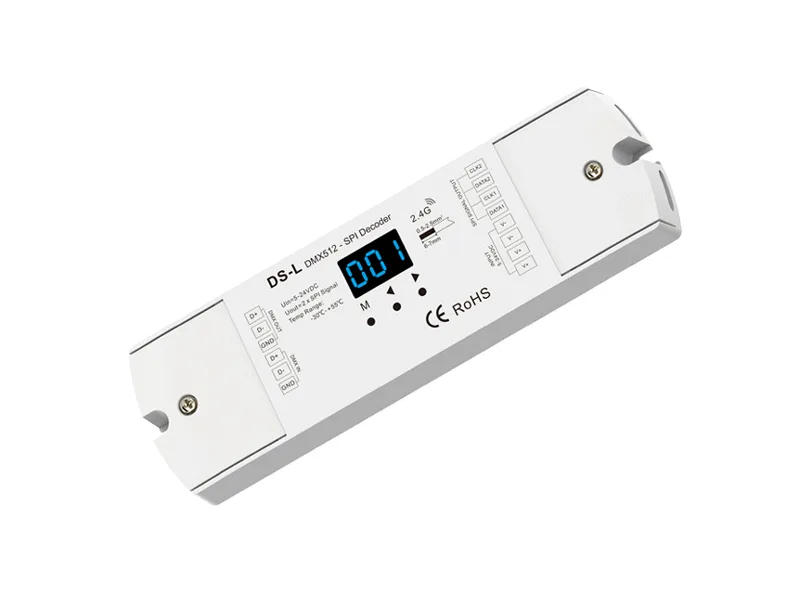
DMX 转 SPI RGB RGBW 解码器和射频控制器
型号CTL-RGB-DMX-DS-L
电源电压:DC5V~24V
功耗:1W
输入信号DMX512 + RF 2.4GHz
输出信号SPI(TTL) x 3/4 通道
动态模式:32
控制点:170 像素(RGB 510 CH),最大 900 像素
尺寸长 175 x 宽 54 x 高 27 毫米
价格: 16.98 美元/件
III. 用于防水 LED 霓虹灯条的 DMX 信号放大器 DA
它用于延长 DMX 信号的传输距离,支持 1 路输入和多路输出。它通过光电隔离技术增强了信号的稳定性,适用于长距离或复杂的电磁环境。
如何配置电源?
DMX512 LED 霓虹灯条系统通常由多个灯段组成,需要根据总负载功率和动态变化预留余量。
1.总负载功率计算:P 总 = ∑(单灯段功率 × 数量)
单灯段功率:DMX512 LED 霓虹灯带每米或每段功率(如 5 W/m)。
举例说明:有 10 段光带,每段 3 米,每米功率为 8 瓦。总功率 = 10 × 3 × 8 = 240 瓦
2.电源额定功率计算功率 = P 总功率 × (1 + 安全系数) ÷ 功率效率 + P (DMX 控制器)
安全系数:建议取 0.2~0.3(DMX 系统可能会有频繁的调光和电流波动)。
电源效率:通常为 85%~95%(开关电源效率更高)。
DMX 控制器功耗:通常为 5~20 W(需参考具体型号)。
例如
总负载 240W,安全系数 0.3,电源效率 90%,控制器功耗 15W:
电源 = 240X1.3÷0.9+15≈303+15=362W
应选择功率≥ 360W 的电源。
品牌电源 (建议使用 Mean Well XLG 系列),以尽量减少信号干扰和压降问题。提供与灯条功率(如 12W/m@RGB)相匹配的稳定电压(通常为 DC12V 或 24V)。
什么是电压降?
简单地说 电压降 是指电流通过 LED 灯具时,电路中电压流动过程中产生的能量损失。这一过程类似于水流通过狭窄的管道,水流的速度会因摩擦而产生一定的能量损耗。对于 LED 灯具来说,电压下降会导致输出功率不足,影响灯具的光效和使用寿命。
LED 灯条的压降问题是指当 LED 灯条连接到电源时,由于电路过长和电流过小带来的电压损失,导致 LED 灯条亮度不够或不均匀。对于长期使用 LED 灯条的用户来说,这个问题非常棘手,因此必须寻求解决办法!
LED 灯条电压下降的原因:
- 电流较小因此,即使在短线路中也会出现电压损失,在长线路应用中更为明显。
- 线路长度:一般来说,驱动器与 LED 灯条之间的线路长度越长,压降问题就越明显。
- 质量问题:LED 灯条的质量也会对压降问题产生影响。一些劣质 LED 灯条可能会因内阻过大或过小而出现压降问题,从而增加线路电阻。
如何为 LED 霓虹灯条的安装选择电线?
DMX512 系统电源电压低(12V/24V DC),线路电流大,压降问题尤为突出,需要保证端电压稳定。
为了保证灯珠前后发光亮度的一致性,避免压降对灯带的影响,通常我们可以采用以下方法:
增加导线直径:降低线路电阻(常用导线直径:1.5mm²、2.5mm²)。
分段供电:长距离布线时,将电源分成多个回路。
提升电源电压:如果末端压降过大,可使用电压稍高的电源(例如,设计一个 24V 系统,而不是 12V)。
要正确处理压降问题,又不能靠加大导体线径,需要考虑成本的增加和布线的合理性。我们可以正确选择以下步骤来进一步补偿压降问题。
步骤 1.计算分接电流
DMX 系统通常分为多个控制电路,需要对每个负载电路进行单独计算:
I 单次 = P 单次/V 功
例如:3 段带材的单负载(3 米 × 8 瓦/米 × 3 段 = 72 瓦),工作电压为 24 伏。
I 单回路 = 72/24 = 3.0A
步骤 2:计算电压降
R=ρ×(2L/A)
ΔU=I 单回路×R 线路
关键参数:
ρ:铜线电阻率,取 0.0172 Ω-mm²/m。
L:从电源到末端的单向距离(单位:米)。
A:导线的横截面积(单位:mm²)。
2L: 当前往返路径的总长度为 2L。
例如
单回路电流 3A,线路单向长度 15 米,使用 1.5mm² 铜线:
R = 0.0172 x (2 x 15/1.5) = 0.344 Ω
电压降: ΔU=3AX0.344Ω≈1.032VV
端电压:24V-1.032V=22.97V(电压降为 4.29%,符合≤5% 的要求)。
允许压降:通常要求不超过工作电压的 5%-10%(12V 系统压降 ≤ 0.6-1.2V,24V 系统 ≤ 1.2-2.4V)。
注意事项
1.信号和电源分离:建议使用独立电源。建议 DMX 控制器和 LED 灯带使用独立电源,以避免干扰。
2.屏蔽线:DMX 信号线需要使用双绞线屏蔽线(如 CAT5e),并与电源线保持 30 厘米以上的距离。
3.分段供电策略:长距离安装时,每隔 20-30 米设置一个电源点,以减少单回路压降。
4.电源同步:当多个电源并联时,应确保共同接地或使用同步模块,以避免电位差干扰 DMX 信号。
5.测量端电压:使用万用表确认端电压≥90% 的额定电压。
6.信号稳定性测试:检查 DMX 信号是否因电源干扰而闪烁或丢包。
7.温升测试:满负荷工作 1 小时后,电源表面温度应≤60℃。
关于室外安装,请参阅相关帖子: 面向建筑师和安装人员的户外 LED 柔性霓虹灯安装解决方案.
概括
DMX 控制 发光二极管 Neon Flex 由于其标准化协议和高抗干扰能力,它已成为建筑照明项目的理想选择。
该技术通过 DMX512 协议实现精确的灯光控制,支持长距离信号传输(最远可达数百米)和多节点同步,可灵活调节亮度、色彩和动态效果,适用于建筑立面装饰、景观照明等场景。
它采用差分信号传输技术,有效避免电磁干扰,并支持断点传输功能,增强系统稳定性。实际应用中需要注意地址设置和线路规划,如利用 DMX512 地址编辑器配置灯具地址,并通过控制器(如 Interact 物联网平台)实现集中管理,优化能耗和维护效率。
DMX512 LED 霓虹灯系统结合智能调光和分区控制,通过合理设计实现精确控制和均匀亮度,同时确保长期可靠运行。
